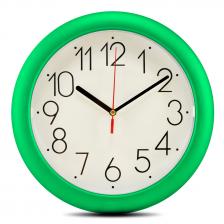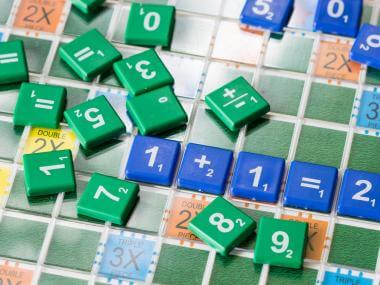How to Solve the Famous Clock Puzzle
How many times each day do the minute and hour hands of a clock cross? At precisely what time does each crossing occur? Keep on reading to learn how to solve this famous math puzzle!

Because, obviously, telling time is a really handy thing to know how to do. But that’s not the only reason I’m glad I can tell time. As it turns out, there are lots of great math puzzles that have to do with the hands of an analog clock. So, I’m thankful to my teacher that I’m now able to enjoy solving them.
Today we’re going to be thinking about and solving exactly one of these puzzles. And after we’re done, I’m pretty sure you’ll be thankful that you learned about clocks, too.
Never miss another tip. Sign up for our Quick and Dirty newsletters to get all your favorite tips delivered straight to your inbox. Sign up now.
The Analog Clock Puzzle
Over the years, I’ve been asked about the puzzle we’re going to talk about today many times. Most recently, math fan David asked me about a brain teaser question:
What time comes next in this sequence? 1:05, 2:11, 3:16, …
“What time comes next in this sequence? 1:05, 2:11, 3:16, …”
If you think about the minute and hour hands of a clock and how they move, you’ll realize that the three times listed here are all times where the two hands overlap. Actually, I should say they’re the approximate times when the two hands overlap. So, the question is, when will this happen again? And then again?
It’s not too hard to picture the hands of a clock and figure out roughly when these crossings should happen. But David and lots of other math fans around the world who have written to me about this problem are curious to know if there is a way to solve for each time more precisely.
The answer is yes! And not only do I have one way to solve this puzzle, I’ve actually have two: a hard way and an easy way. Let’s start with the harder way.
The Hard Solution: The Minute Hand
For a brief instant at midnight and at noon, the minute and hour hands of a clock are both pointed straight up. After that moment, the minute hand moves forward, marching at its rate of 60 tick marks per hour. This means that each of those tick marks on the clock correspond to one minute of time for the minute hand. (Which is why it’s called the minute hand!)
We can find the position of the minute hand at any later time by multiplying the number of hours that have passed since midnight by its rate of travel—60 ticks per hour. The result of this multiplication tells us the tick mark at which we can find the minute hand. Well, almost … because after one hour, this calculation will tell us that the minute hand is at the 60th tick mark, and then the 61st, the 62nd, and so on.
But what we really want is to have the minute hand’s position return to 0 (straight up), and then the 1st tick, the 2nd tick, and so on, each time it goes around. If you’ve been following the show for a while, you may remember talking about something called modular arithmetic which is tailor made for dealing with exactly this situation. Using the language of modular arithmetic, what we really want to do when calculating the position of the minute hand on a clock is to multiply the number of hours since midnight by the 60 ticks per hour rate of travel…modulo 60.
In other words, we want to find the total number of tick marks traveled, and then find the remainder when we divide this number by 60 (that’s what the modulo operator means). So, if 1.5 hours have passed, this means that the minute hand will be at (1.5 x 60) mod 60 = 90 mod 60 = 30, which is exactly what we want.
The Hard Solution: The Hour Hand
How about the position of the hour hand? Since it completes one entire journey around the clock—which is 60 tick marks—in 12 hours, it must travel 60 / 12 = 5 tick marks per hour. So, starting from its position straight up at midnight and at noon, we can find its position by multiplying the number of hours that have passed by its 5 tick marks per hour rate of travel. We don’t have to worry about taking the modulus here since the hour hand takes 12 hours to complete one trip around the clock, which is the total amount of time we need to worry about in our puzzle.
Our goal is to figure out when the two hands will be at the same place at the same time.
So, we now know where both hands will be on the clock face at any time. Remember, our goal is to figure out when the two hands will be at the same place at the same time. In other words, we want to know when the position of the hour hand is equal to the position of the minute hand. Since we’ve come up with an expression for the position of each, all we have to do is set these equal to each other. In other words, all we have to do is solve the equation
[(60 ticks / hour) x time] mod 60 = (5 ticks / hour) x time
for the various times that make it true. And we could do that, and we would get the right answer, but it turns out there’s an easier way.
The Easy Solution to the Clock Puzzle
As it turns out, all we really have to do to solve this problem is think about it. That’s right, we don’t have to solve any equations! Here’s the idea: we first need to figure out how many times the two hands cross each other every 12 hours (that’s one complete trip around the clock for the hour hand).
Well, they begin in an overlapping position at midnight, so that’s 1 time. An hour later the minute hand is back pointing straight up and the hour hand has moved five ticks forward, so they haven’t yet crossed again. But a few minutes later—a little more than five minutes later, in fact—the minute hand catches back up to the hour hand. So, that’s 2 crossings. And if you think about it, you’ll see that they cross a 3rd time a little after 2:10, and then a 4th time a bit after 3:15, and on and on all the way up to an 11th crossing a few minutes before 11 o’clock. Their next crossing after that is at noon when both hands are pointed straight up again, right back where we started.
So that means that the two hands cross a total of 11 times every 12 hours. And since the hands always move at a constant rate, it means that they cross each other every 12/11 of an hour. In other words, there are 12 hours per 11 crossings, or about 12/11 = 1.09 hours per crossing. If you multiply 1.09 by 60 minutes, you’ll find that the two hands must cross every time that 1 hour and 5.45 minutes passes. Or, in terms of hours, minutes, and seconds, the two hands of a clock must cross each other every 1 hour 5 minutes and 27 seconds.
 Wrap Up
Wrap Up
Okay, that’s all the math we have time for today.
For more fun with math, please check out my book, The Math Dude’s Quick and Dirty Guide to Algebra. And remember to become a fan of The Math Dude on Facebook, where you’ll find lots of great math posted throughout the week. If you’re on Twitter, please follow me there, too.
Until next time, this is Jason Marshall with The Math Dude’s Quick and Dirty Tips to Make Math Easier. Thanks for reading, math fans!
Clock image from Shutterstock.


 Wrap Up
Wrap Up



